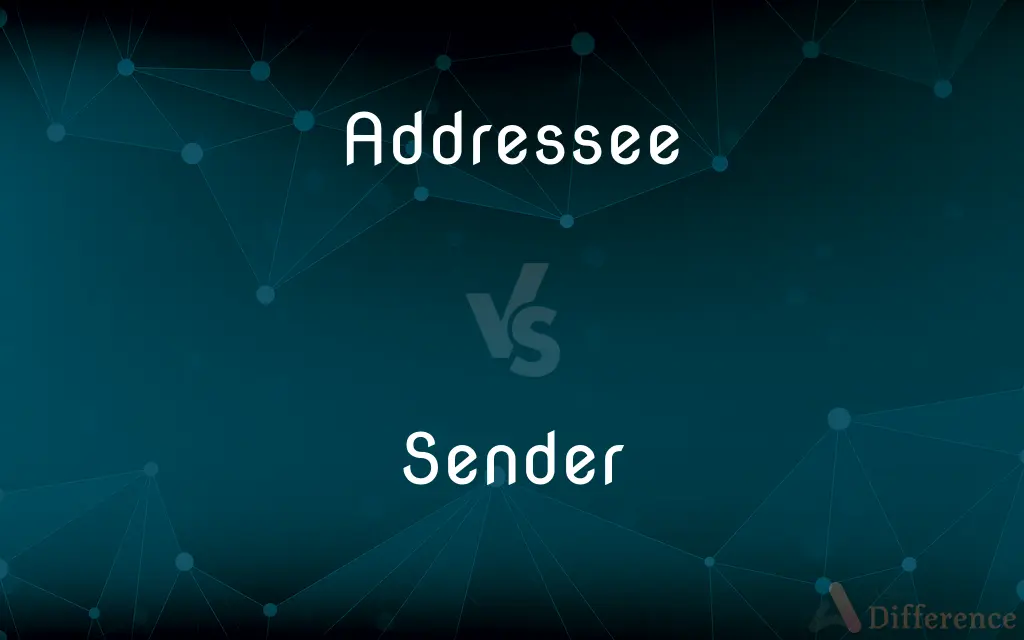Addressee vs. Sender — What's the Difference?
By Tayyaba Rehman & Maham Liaqat — Updated on March 27, 2024
The addressee is the recipient of a message or parcel, while the sender is the one who dispatches it, highlighting their roles in communication.

Difference Between Addressee and Sender
Table of Contents
ADVERTISEMENT
Key Differences
The addressee is identified as the individual or entity to whom a message, letter, package, or email is directed. Their role is passive in the sense that they receive the communication initiated by another party. On the other hand, the sender is the originator of the message, actively choosing to initiate communication by dispatching a letter, email, or parcel to the addressee.
While the addressee's primary action is to receive and possibly respond to the communication, the sender is responsible for ensuring that the message is clearly articulated and reaches the intended recipient. This dynamic places the onus on the sender for the clarity and delivery of the message, whereas the addressee is tasked with interpretation and subsequent response.
In the context of postal services or email communication, the addressee's information is typically placed on the front or center of an envelope or at the beginning of an email, clearly indicating to whom the communication is intended. Conversely, the sender’s information is often found in the top left corner of an envelope or in the email header, indicating from whom the message has originated.
The relationship between sender and addressee is crucial in various forms of communication, including legal documents, where the roles are strictly defined and regulated. The sender must ensure the accuracy of the addressee's information to avoid misdelivery, highlighting the importance of correct addresses and recipient details.
Comparison Chart
Role
Recipient of the message or package
Initiator of the communication
ADVERTISEMENT
Action
Receives and responds to communication
Dispatches and ensures delivery
Information Placement
Front or center of envelope/email
Top left corner of envelope/email header
Responsibility
Interpretation and response
Clarity, articulation, and delivery
Contexts
Postal, email, legal documents
Postal, email, business communications
Compare with Definitions
Addressee
In digital communications, the recipient of an email or digital message.
The email's addressee was accidentally left out of the To field.
Sender
The person or organization that sends a message, letter, or parcel.
The sender included a return address on the package in case of delivery issues.
Addressee
An individual or entity designated to receive a specific message or item.
The package's label included the addressee's address and phone number.
Sender
The originator of a communication, responsible for its content and dispatch.
The sender of the letter chose an express mail service for faster delivery.
Addressee
The person or organization intended to receive a message, as opposed to bystanders or unintended recipients.
The memo’s addressee was the entire sales department.
Sender
The entity responsible for the packaging and mailing of an item.
The sender ensured that the fragile items were securely packaged.
Addressee
The recipient of a letter, package, or email.
The addressee's name was printed clearly on the envelope.
Sender
In email communication, the individual or entity originating the email.
The sender of the phishing email disguised their address.
Addressee
In legal terms, the party to whom a legal document is directed.
The court document listed Jane Doe as the addressee.
Sender
In transactions, the party that initiates the transfer of goods or information.
The sender of the payment received confirmation within minutes.
Addressee
The one to whom something is addressed.
Sender
A sender was a special type of circuit in 20th-century electromechanical telephone exchanges which registered the telephone numbers dialed by the subscriber, and then transmitted that information to another exchange. In some American exchange designs, for example, the No.
Addressee
The person or organization to which something, such as a letter or message, is addressed or sent, for whom the item is intended.
Sender
A person who sends or transmits a message, letter, email, etc.
Senders of unwanted emails
Evidence submitted late will be returned to the sender
Addressee
(linguistics) A person or entity to whom discourse is directed, or the words referring to such an entity.
Sender
To cause to be conveyed by an intermediary to a destination
Send goods by plane.
Addressee
One to whom anything is addressed.
Sender
To dispatch, as by a communications medium
Send a message by radio.
Addressee
One to whom something is addressed
Sender
To direct to go on a mission
Sent troops into the Middle East.
Sender
To require or enable to go
Sent her children to college.
Sender
To direct (a person) to a source of information; refer
Sent the student to the reference section of the library.
Sender
To give off (heat, for example); emit or issue
A stove that sends forth great warmth.
Sender
To utter or otherwise emit (sound)
Sent forth a cry of pain.
Sender
To hit so as to direct or propel with force; drive
The batter sent the ball to left field. The slap on my back sent me staggering.
Sender
To cause to take place or occur
We will meet whatever vicissitudes fate may send.
Sender
To put or drive into a given state or condition
Horrifying news that sent them into a panic.
Sender
(Slang) To transport with delight; carry away
That music really sends me.
Sender
To dispatch someone to do an errand or convey a message
Let's send out for hamburgers.
Sender
To dispatch a request or order, especially by mail
Send away for a new catalogue.
Sender
To transmit a message or messages
The radio operator was still sending when the ship went down.
Sender
Someone who sends.
The package was addressed to someone we didn't know, so we returned it to the sender.
Sender
A device or component that transmits, as in telegraphy or computer networks.
Sender
One who sends.
Sender
Someone who transmits a message;
Return to sender
Sender
Set used to broadcast radio or tv signals
Common Curiosities
What defines an addressee in communication?
The addressee is the intended recipient of a message, letter, or package, defined by their receipt of the communication.
What information is crucial for a sender to include?
For effective delivery, a sender must include accurate recipient (addressee) details and a return address or contact information.
How does one become a sender?
One becomes a sender by initiating communication, whether through sending a letter, an email, or dispatching a parcel.
Why is the accuracy of the addressee's information important?
Accurate addressee information ensures the successful delivery of the message or package to the intended recipient.
How do legal documents define senders and addressees?
Legal documents strictly define senders and addressees by their legal names and addresses to ensure accountability and proper delivery.
Is consent required to become an addressee?
Typically, consent is not required to become an addressee, though laws and regulations regarding unsolicited communications may apply.
Can the roles of sender and addressee interchange?
Yes, in ongoing communication, the roles can interchange as the initial addressee responds, becoming the sender of the reply.
What happens if the sender's information is incorrect or missing?
Incorrect or missing sender information can lead to delivery issues or prevent return communication if there are problems with the message or parcel.
In digital communications, how are senders and addressees identified?
In digital communications, senders and addressees are identified by their email addresses, with the sender’s address in the "From" field and the addressee’s in the "To" field.
Can there be multiple addressees for a single message?
Yes, a message, email, or document can have multiple addressees, as indicated by addressing details or distribution lists.
How can senders ensure their messages are received as intended?
Senders can ensure receipt by verifying addressee information, using reliable delivery services, and requesting delivery confirmation.
How do businesses use the sender-addressee model?
Businesses use this model for marketing, transactions, and customer communication, carefully managing sender and recipient details for effectiveness.
What are the consequences of misidentifying an addressee?
Misidentifying an addressee can lead to breaches of privacy, misdelivered information, and legal implications, especially in sensitive communications.
What role does the postal service play in sender-addressee dynamics?
The postal service acts as the intermediary, responsible for the physical transfer of messages and packages from the sender to the addressee.
What technologies aid in managing sender and addressee information?
Technologies like email management systems, CRM platforms, and postal tracking services aid in accurately managing and tracking communication.
Share Your Discovery

Previous Comparison
Earthworm vs. Nightcrawler
Next Comparison
Climatised vs. ClimatizedAuthor Spotlight
Written by
Tayyaba RehmanTayyaba Rehman is a distinguished writer, currently serving as a primary contributor to askdifference.com. As a researcher in semantics and etymology, Tayyaba's passion for the complexity of languages and their distinctions has found a perfect home on the platform. Tayyaba delves into the intricacies of language, distinguishing between commonly confused words and phrases, thereby providing clarity for readers worldwide.
Co-written by
Maham Liaqat














































